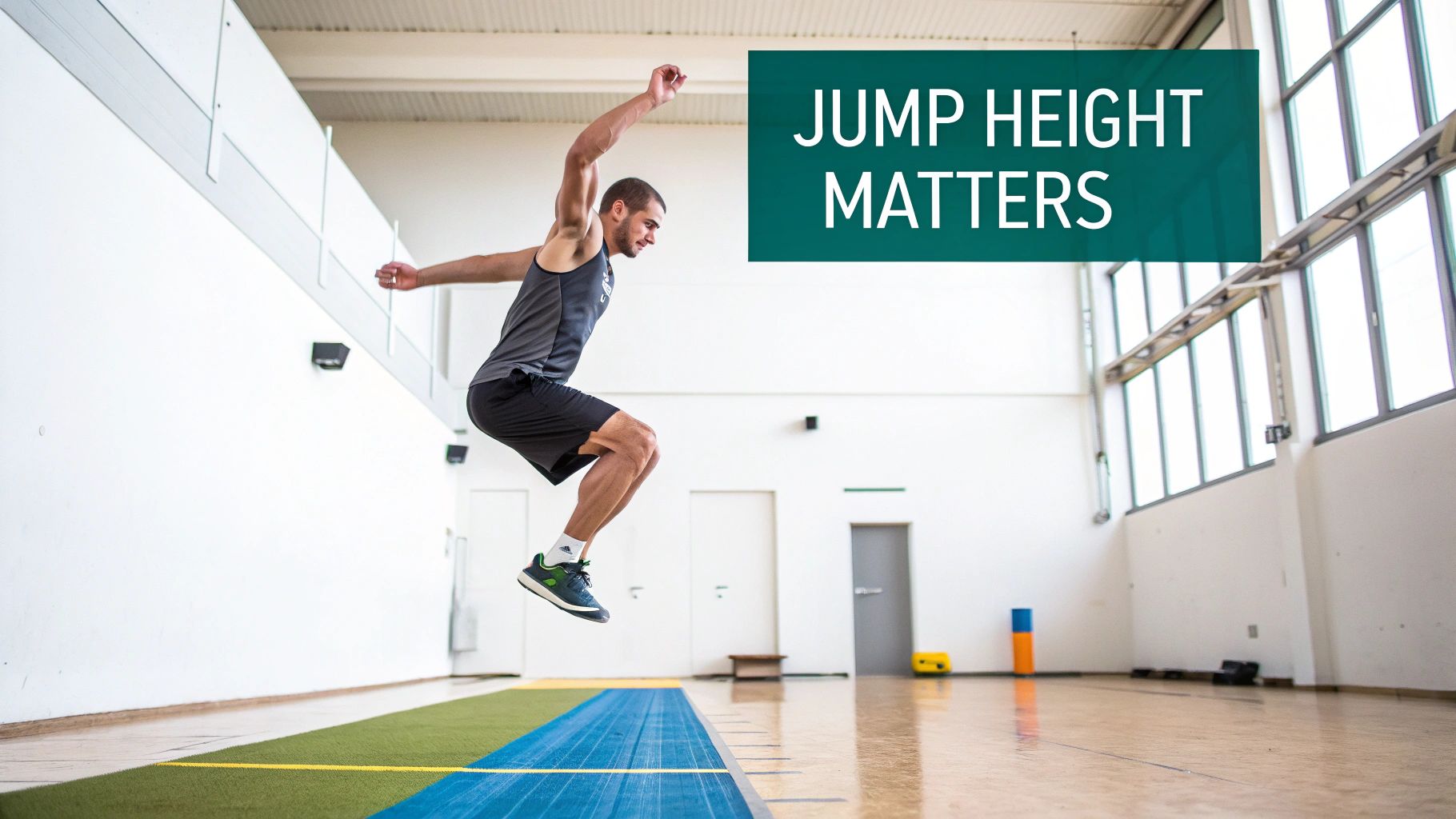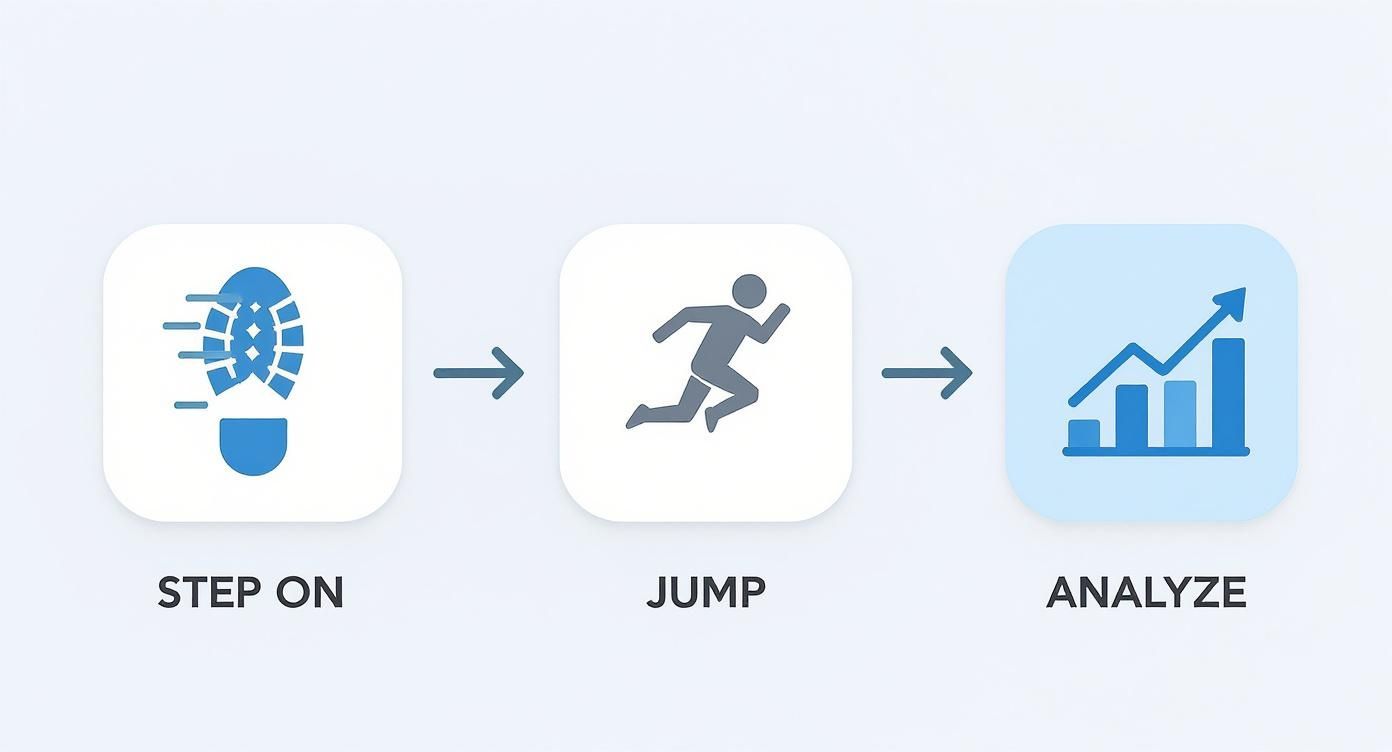-

, by Marko Dombi Athlete-Centric Care: Elevating ACL Rehab with Next-Gen Performance Tools
-

, by Marko Dombi Launch of the EasyBase - Force Plate System For Rehabilitation and Sports
-

, by Marko Dombi Interview with the researcher | Enhanced Paper Grip Test Project
How to Measure Jump Height: An Athlete's Guide
- , by Team Meloq
- 20 min reading time

Learn how to accurately measure jump height using methods trusted by sports scientists. Explore tools from force plates to phone apps.
When it comes to measuring jump height, athletes and coaches have a whole arsenal of tools at their disposal, from old-school wall tests to lab-grade force plates and even the smartphone in your pocket. Each method can provide valuable data on explosive power. The real key, however, is measuring consistently and precisely to track progress and make smart training decisions. This single metric offers a powerful window into an athlete's lower-body strength and neuromuscular readiness.
Why Jump Height Is a Critical Performance Metric

For those of us obsessed with performance, vertical jump height is so much more than just a number—it’s a vital sign of raw athletic power. A single jump can reveal a surprising amount about an individual's neuromuscular system, making it a cornerstone of any serious physical performance testing protocol.
Forget the guesswork. Whether you're in a high-tech lab or just using your phone, reliable data is entirely achievable.
The ability to generate force quickly against the ground underpins almost every athletic movement, from sprinting and jumping to cutting on a dime. That's why the vertical jump is such a direct and practical measure of lower-body explosive power. The test is scientifically validated as a strong indicator of an athlete's capacity for power production (1).
A Window into Athletic Potential
Consistently tracking jump height gives you the feedback needed to fine-tune training programs. If performance plateaus or drops, it might be time to adjust training loads. If it's steadily climbing, you know the conditioning plan is working. It helps answer the big questions:
- Is our strength training actually translating into explosive power?
- Are the plyometric drills improving reactive strength?
- Is the athlete getting enough recovery between sessions?
This metric’s value is clear across countless sports. In professional scouting, especially for American football, the vertical jump is a go-to indicator of explosive leg power. Just look at Gerald Sensabaugh, who reportedly hit a 46-inch (116.8 cm) vertical at the NFL Combine. That’s the kind of power that creates game-breaking plays.
For comparison, professional basketball players typically land in the 28 to 33-inch (71-84 cm) range. Then you have outliers like elite high jumper Javier Sotomayor, who cleared 2.45 meters (8 ft 0.25 in) with a running start—a world record that still stands today. You can learn more about the highest jumps in sport.
Monitoring Fatigue and Readiness
Beyond just tracking peak performance, jump height is an incredibly sensitive marker for neuromuscular fatigue. A noticeable drop in an athlete's typical jump height can be an early warning sign of overreaching or incomplete recovery—often before the athlete even feels tired (2).
By weaving regular jump testing into a monitoring routine, coaches can make smarter, data-informed decisions about an athlete's readiness to train or compete. This objective layer of data, complementing subjective feedback, can be a game-changer in potentially reducing the risk of non-contact injuries.
Lab-Grade Tools: Force Plates and Contact Mats
When you absolutely need precision, sports scientists and high-performance coaches rely on specialized equipment to measure jump height. These tools take the guesswork out of the equation, giving you objective, repeatable data that forms the foundation of any serious athletic monitoring program.
In the world of biomechanics and performance labs, force plates are the undisputed 'gold standard' (1).
A force plate is a fascinating piece of technology. It doesn't actually measure how high you jump in a direct sense. Instead, it measures the ground reaction forces you produce during the entire jump, from the dip to the landing. From there, sophisticated software uses the impulse-momentum relationship to calculate your takeoff velocity. This velocity is the key to determining the precise height of your center of mass with incredible accuracy.
You can take a much deeper dive into the mechanics and applications in our comprehensive guide to force plate testing. This method gives you a treasure trove of data that goes way beyond simple jump height, including force production rates, limb asymmetries, and timing for different phases of the jump. It’s a complete snapshot of an athlete's neuromuscular function.
The Role of Contact Mats
While force plates provide an unparalleled level of detail, their cost and complexity can be a barrier for many. That’s where contact mats (also known as jump mats) come in as a fantastic, practical alternative.
A contact mat operates on a much simpler principle: it measures flight time. The mat has a built-in switch that starts a timer the instant your feet leave the surface and stops it the second they touch back down. With that flight time, a simple physics formula calculates the vertical jump height.
From Flight Time to Jump Height: Jump Height = (g × t²) / 8 Where 'g' is the acceleration due to gravity (~9.81 m/s²) and 't' is the flight time in seconds.
This approach is highly validated for measuring jump height and is far more portable and accessible than a full force plate system (2).
Comparing High-Precision Jump Measurement Tools
Choosing between these two excellent tools often comes down to balancing detail, budget, and logistics. This table breaks down the key differences to help you decide which is the right fit for your needs.
| Feature | Force Plates | Contact Mats |
|---|---|---|
| Primary Measurement | Ground Reaction Force | Flight Time |
| Accuracy | Very High (Gold Standard) | High |
| Data Provided | Jump height, power, velocity, force-time curve, asymmetries | Jump height, flight time, contact time |
| Portability | Generally low; often lab-based | High; easily transported |
| Cost | High | Moderate |
| Best For | In-depth biomechanical analysis, research, elite performance | Field testing, team screening, budget-conscious labs |
Ultimately, both force plates and contact mats offer reliable ways to quantify lower-body power. The best choice depends on whether you need a comprehensive biomechanical profile or a quick, accurate measure of jump height in a more flexible setting.
Standardizing Your Jump Protocols
To get data you can trust from either tool, you have to be obsessive about standardizing your testing protocol. If the test changes, the data is useless. Two of the most common jump variations you’ll see are the Countermovement Jump (CMJ) and the Squat Jump (SJ), and each tells you something different.
- Countermovement Jump (CMJ): The athlete starts tall, performs a rapid dip, and immediately explodes upward. This is your go-to for measuring reactive strength and how well an athlete uses the stretch-shortening cycle.
- Squat Jump (SJ): The athlete gets into a squat (usually around a 90-degree knee angle), pauses for a moment to kill any momentum, and then jumps. This isolates pure concentric power.
One of the biggest variables you need to control is arm swing. Letting an athlete use their arms can increase jump height by 10% or more because the arms contribute to the upward drive (3). To isolate the lower body's contribution, tests are often done with hands on the hips (akimbo).
Whatever you choose—arms free or akimbo—you have to stick with it. Consistency is king if you want to compare data over time.
References
- Markovic G, Dizdar D, Jukic I, Cardinale M. Reliability and factorial validity of squat and countermovement jump tests. J Strength Cond Res. 2004;18(3):551-5.
- Gathercole RJ, Stellingwerff T, Sporer BC. Effect of Tapering on Neuromuscular Performance in Elite Cyclists: A Case Study. Int J Sports Physiol Perform. 2015;10(4):530-5.
- Harman EA, Rosenstein MT, Frykman PN, Rosenstein RM. The effects of arms and countermovement on vertical jumping. Med Sci Sports Exerc. 1990;22(6):825-33.
Measure Jump Height with Everyday Technology
You don’t need a state-of-the-art lab to get meaningful data on your vertical jump. In fact, a surprisingly accurate and accessible tool is probably already in your pocket. The technology packed into modern smartphones offers a fantastic alternative to expensive lab equipment.
The key is your phone's slow-motion video feature. By capturing your jump at a high frame rate, you can isolate the one variable that matters most for this calculation: flight time. This is the exact same principle a contact mat uses, but instead of a physical switch, you're using video frames. It’s a method that’s been well-supported in sports science literature for its validity when performed correctly (1).
Using Slow-Motion Video for Analysis
Most smartphones today can record video at high frame rates, like 240 frames per second (fps). This gives you the power to break down the jump into tiny slivers of time. From there, you can analyze the footage frame-by-frame to pinpoint the exact moment your feet leave the ground and the instant they touch back down.
Once you have the video, the process is pretty straightforward:
- Count the frames: Go through the video and count the total number of frames you were completely in the air.
- Calculate flight time: Divide your airborne frame count by the camera's frame rate. For example, 48 frames / 240 fps = 0.2 seconds of flight time.
- Calculate jump height: With your flight time (t), you just plug it into a simple physics equation: Jump Height = (9.81 × t²) / 8.

For this to be reliable, you have to be consistent. Always set your phone up on a stable tripod at the same height and distance from your jump spot. This keeps the perspective the same across all your tests, which is absolutely crucial for accurate frame counting. This level of detail is a cornerstone of any good analysis of movement.
Leveraging Mobile Apps for Automation
While counting frames by hand certainly works, several mobile apps can do all the heavy lifting for you. These apps use your phone’s camera to perform the video analysis automatically, calculating flight time and jump height with just a couple of taps.
Many of these apps have even been validated against gold-standard equipment like force plates, showing a high degree of correlation and reliability (2). They’re essentially doing the same frame-by-frame analysis, but their algorithms detect takeoff and landing, which removes the potential for human error in counting.
A key takeaway here is that the accuracy of these apps really depends on following their setup instructions to the letter. Factors like camera angle, lighting, and even the contrast of your background can all affect how well the algorithm tracks your movement.
Some apps take it a step further and use your phone's built-in accelerometer. For these, you might strap the phone to your body or even just hold it. The device’s sensors then measure the acceleration changes during the jump to calculate height. It's convenient, but the accuracy can be more variable and is highly dependent on securing the phone properly to minimize any extra movement.
No matter which technology you choose, the basic principles of good data collection still apply. Always go through a proper warm-up, keep your technique consistent for every jump, and give yourself enough rest between attempts. That’s how you ensure you're measuring your true peak performance.
References
- Balsalobre-Fernández C, Tejero-González CM, del Campo-Vecino J, Bavaresco N. The validity and reliability of an iPhone app for measuring vertical jump height. J Sports Sci. 2014;32(15):1491-6.
- Stanton R, Kean CO, Scanlan AT. My Jump for vertical jump assessment. Br J Sports Med. 2015;49(17):1157-8.
Putting Your Jump Data into Context
So, you've measured your jump height and now you have a number. What's next? By itself, that number is just a piece of data. Its real power comes from putting it into context—understanding what it actually means for you as an athlete.
A great place to start is by seeing how your result stacks up against established benchmarks. It gives you a quick snapshot of where you stand. Vertical jump height can vary significantly based on age, training background, and competitive level, which is what makes these comparisons so useful.
For instance, most college-aged male athletes typically hit somewhere between 24 to 26 inches (61-66 cm), which may reflect their peak neuromuscular development. High school males are often in the 20 to 24 inch (51-61 cm) range, and younger teens are closer to 17 inches (43 cm). Then you have professionals in explosive sports like basketball, who are often clearing 28 to 33 inches (71-84 cm) thanks to years of specialized training.
These numbers highlight how much targeted exercise and good technique can influence performance. You can dig into more science-backed benchmarks and proven ways to improve to see how different groups compare.
Beyond a Single Snapshot
While comparing your numbers to others is insightful, the true magic of jump data lies in tracking your own performance over time. A single measurement is just a moment in time, but a series of tests tells a story about your training, recovery, and overall readiness. This is how a simple test evolves into a powerful monitoring tool.
Once you establish a baseline for your typical jump height, you can start to read the fluctuations. Is your jump height trending up? That’s a fantastic sign that your training program is building explosive power. It’s the kind of objective feedback that keeps you motivated and confirms your hard work is paying off.
The goal isn't just to get a single "good" number, but to understand what your numbers are telling you week after week. Consistent tracking transforms jump testing from an assessment into a conversation with your own physiology.
Decoding the Fluctuations
On the flip side, a sudden or steady drop in your jump height can be an incredibly valuable early warning. It often signals that neuromuscular fatigue is creeping in, sometimes long before you actually feel tired or run down (1). This kind of objective data can be a game-changer for avoiding overtraining.
Consider these real-world scenarios:
- Minor Drop After Hard Training: A slight dip the day after a strenuous leg session is completely normal—even expected. It's a good sign the workout provided a strong stimulus.
- Consistent Downward Trend: If your jump height stays low for a few days or keeps dropping, it’s a red flag. This might mean you aren't recovering enough between sessions.
- Stagnation or Plateau: If your numbers aren't budging for several weeks despite consistent training, it could be time to switch things up. Your body might need a new stimulus or a different program design.
By paying close attention to these trends, athletes and coaches can make smarter, data-driven calls. You'll know when it's time to push harder, when to pull back and focus on recovery, and how to tweak training loads for optimal long-term progress.
References
- Gathercole RJ, Stellingwerff T, Sporer BC. Effect of Tapering on Neuromuscular Performance in Elite Cyclists: A Case Study. Int J Sports Physiol Perform. 2015;10(4):530-5.
Predicting Jump Height with Barbell Velocity

What if you could get a solid read on an athlete's jump height potential without them ever leaving the floor? It may sound unusual, but it's a proven and practical method used in modern strength and conditioning. Instead of measuring air time, we're looking at the speed of a loaded barbell during a squat jump.
This is the foundation of velocity-based training (VBT). Specialized sensors are attached to the bar that provide real-time feedback on movement speed. It’s a shift from focusing only on how much weight is on the bar to how fast an athlete can move it. That speed gives us a direct window into their power output and neuromuscular readiness on any given day.
The Science Behind Barbell Speed
The link between how fast you can move a barbell and how high you can jump is remarkably strong. Research has identified a powerful correlation: the peak velocity an athlete achieves during a loaded squat jump directly relates to their potential vertical jump height.
The rationale is straightforward. The faster you can propel a load upwards, the more explosive power you possess. That same power is what propels you vertically.
One of the biggest advantages of this method is that it’s a low-fatigue way to monitor power week in and week out. A full jump testing session can be demanding, but a few reps of a loaded squat jump can be integrated into a warm-up without adding much stress.
By tracking barbell velocity, we can instantly gauge an athlete's readiness, assess if a training block is effective, and make smart adjustments on the fly. If velocity drops, it might be a sign of fatigue. If a new personal record is hit, we know the athlete is adapting well.
The Predictive Formula
We now have the tools to turn this concept into hard numbers. A key study established a strong predictive model by recording barbell velocity during loaded squat jumps.
The formula they developed is Jump height (cm) = 16.577 × Vmax − 16.384. This linear regression model allows practitioners to estimate an athlete's vertical jump with impressive accuracy. The best part? It's been validated across different loads for both men and women, making it a reliable tool. You can dive into the research behind this predictive model for a closer look (1).
This powerful relationship between speed and strength is also the foundation for concepts like the Dynamic Strength Index, which compares an athlete's maximal strength against their explosive strength. If you want to get a better handle on this, check out our in-depth guide on the Dynamic Strength Index.
Ultimately, using VBT to predict jump height turns a standard strength exercise into a dual-purpose assessment, blending training and testing into one seamless, efficient process.
References
- García-Ramos A, Pestaña-Melero FL, Pérez-Castilla A, Rojas FJ, Haff GG. Mean velocity vs. peak velocity: which variable determines squat jump height with the bar correctly positioned on the shoulders? J Strength Cond Res. 2018;32(5):1290-6.
Common Questions About Jump Height Measurement
When you start digging into vertical jump testing, a few common questions always seem to pop up. Getting these details straight is key for anyone who wants to accurately measure jump height and understand what the results mean.
The right answer often boils down to what you're trying to figure out. Are you interested in pure, raw lower-body power? Or are you trying to see how well an athlete uses their entire body to get airborne? Let's tackle some of the most frequent questions with a little help from science.
Standing Jumps Versus Running Jumps
One of the first things people get confused about is the difference between a standing jump and a running jump. It’s important to know they are completely different tests that look at distinct athletic abilities.
A standing jump, like the classic Countermovement Jump (CMJ), really zeroes in on the explosive power an athlete can generate from their lower body, starting from a static position. On the other hand, a running jump lets the athlete use horizontal speed and convert it into vertical lift, which naturally leads to a much higher number. This approach is more specific to what you'd see in a game, like a basketball player going for a layup or a volleyball player attacking the net.
When you measure jump height, you have to decide which of these qualities you care about and then stick with that method every single time.
You absolutely cannot mix and match these results. The running jump will almost always be higher, but the standing jump gives you a cleaner, more isolated look at raw power production from the legs.
Should You Use an Arm Swing?
The arm swing is another huge variable. Letting an athlete use their arms can boost their jump height by 10% or more compared to a jump where their hands are on their hips (akimbo) (1). That coordinated, powerful arm swing adds a significant amount of upward momentum, contributing to the total force they generate.
So, which one is better? It depends.
- With an Arm Swing: This is more "ecologically valid." In other words, it's a much better reflection of how an athlete actually jumps in their sport. You're measuring total-body coordination and power.
- Without an Arm Swing (Akimbo): This method isolates the lower body's contribution. It gives you a more specific measure of pure leg power and is often the go-to in research settings to keep variables to a minimum.
Neither approach is wrong, but just like with the running start, consistency is everything. If you're looking for more deep dives into athletic performance and answers to common questions, the Playpause blog has some great articles worth checking out.
How Reliable Are Smartphone Apps?
Let's be honest, the convenience of using a smartphone app is hard to beat. Many apps that use slow-motion video to calculate an athlete's flight time have actually shown solid reliability and validity when compared to gold-standard gear like force plates (2).
But there’s a catch. Their accuracy completely depends on a controlled setup. You need a stable camera, good lighting, and a consistent protocol—those are non-negotiable. Apps that only use the phone's internal accelerometer can be a bit more hit-or-miss because where you place the phone can throw off the results.
References
- Harman EA, Rosenstein MT, Frykman PN, Rosenstein RM. The effects of arms and countermovement on vertical jumping. Med Sci Sports Exerc. 1990;22(6):825-33.
- Stanton R, Kean CO, Scanlan AT. My Jump for vertical jump assessment. Br J Sports Med. 2015;49(17):1157-8.
At Meloq, we believe in the power of precise, objective data to guide performance and rehabilitation. Our suite of digital measurement tools provides clinicians and coaches with the accuracy needed to make informed decisions. Move beyond estimation and start quantifying performance with tools designed for reliability and ease of use. Discover the full ecosystem at https://www.meloqdevices.com.



